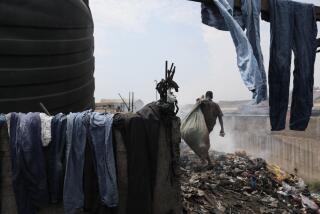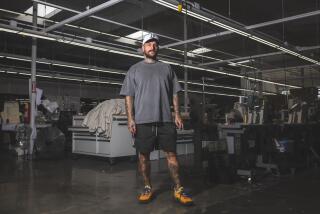The dark side of faking it in L.A.
A few years ago, if you wanted a faux Louis Vuitton bag that could pass for the real deal, all you had to do was mosey down Santee Alley -- L.A.’s bustling ground zero for counterfeit fashion -- and pick one up.
Amid the cheesy “Louis Wuitton” and “Channel” satchels, there were always a few fabulous impostors, usually positioned behind or just under the front register. Those near-perfect renditions might’ve been priced at $100 or even $200 -- but that was a fraction of the $2,000-plus a genuine bag would fetch.
Over the last two years, say close observers of the scene, even the move away from heavily labeled “it” bags and status jeans hasn’t dampened the demand for high-quality counterfeit luxury fashion -- the illegal fakes that strive to try to mimic the real thing down to the stitching and logo on the zipper. But procuring the spot-on stuff has gotten more complicated, in large part because of the Los Angeles Police Department’s crackdown on counterfeiting.
In the complex cat and mouse game on Santee, vendors have become so cagey, says Rick Ishitani, one of six detectives on LAPD’s Anti-Piracy Task Force, that they even know the license plate numbers of undercover cop cars. And they know better than to flash high-quality merch in public. Instead, they stash the goods in bulk in nearby warehouses and apartments.
You want a perfect copy of the Marc Jacobs quilted Bruna bag? You’ll need to fish around the Alley to figure out who can hook you up -- and then you may have to wait 30 minutes for someone to fetch the item from a neighboring location, said Kris Buckner, who chases down counterfeiters for fashion clients such as True Religion as a private investigator for his Lawndale-based Investigative Consultants.
The Anti-Piracy Task Force has brought more than 25 big-fish counterfeiting operations to justice this year. Factor in all the arrests made by vice units on small-time sellers and distributors, and more than 3,000 people in L.A. have been arrested for dealing in counterfeit goods since January, according to Ishitani.
The task force was launched in response to a 2007 report from the Los Angeles Economic Development Corp. estimating that the loss to L.A. County companies from piracy and counterfeiting was about $5.2 billion in 2005. And since its formation, the underground landscape has evolved, Ishitani says.
“Santee is slowly transitioning into Canal Street in New York.” Counterfeiters, he notes, “aren’t as blatant as they used to be. People say, ‘Wow, it’s cleaned up a lot.’ But it’s really just hidden.”
Now the Alley is thick with pirated designs -- knockoffs that don’t bear exact labels or tags and therefore would be hard-pressed to be mistaken for the real thing. This second-class high fashion -- sunglasses emblazoned with “DG” instead of “D&G;,” earrings printed with a Juicy Couture-inspired crown -- is 100% legal to make and sell under current laws.
Makers and sellers of the illegal fakes, meanwhile, have found ever more sophisticated ways to bring in their counterfeit goods.
“Stuff will come into the [local ports] where the front of the container will be full of legitimate product and the back will be counterfeit stuff, so if it’s searched, it passes,” Bruckner says.
Faux fashion also comes into the ports hidden in plain sight. Counterfeiters “put a generic cover around a Louis Vuitton purse, and then the vendors cut it off and there’s the purse,” Ishitani says. The same method goes for hiding premium denim. “There will be a thin layer of cloth that covers the True Religion patch that sellers will just cut off.”
Changes at the ports and in the law have made invention a necessity when smuggling illegal fashion into Southern California. The number of customs inspectors has dramatically increased since the Sept. 11 attacks, and until last year, so had the amount of cargo moving through the ports, says Jim MacLellan, director of trade services for the Port of Los Angeles. “But in [early] 2008, volume turned down, and the percentage of inspections went up because there are still the same number of customs inspectors.”
In short, there are more eyeballs on all containers coming off the ships, including those shipped from factories in China and the Philippines, where the bulk of counterfeit fashion is created.
There’s also more culpability on the front end of the shipping importation process. Merchandise must be listed on manifests, with the factory that made it named, before anything’s loaded onto a ship.
“If it’s counterfeit goods, now they have the name of the factory it came from, which they never had before,” says Ilse Metchek, executive director of the California Fashion Assn.
“You can have a fake factory name, but then everyone gets arrested,” she says. That’s because in February, U.S. Customs and Border Protection implemented a rule mandating that “everyone is responsible if something [counterfeit] comes through: the factory, the shipper, the shipping company and the receiver,” Metchek says.
There’s no prototypical dealer for the counterfeit goods that do make it through, says Buckner, who has noted among recent offenders professional women in the San Fernando Valley who throw Mary Kay-style “purse parties,” fashion boutique owners, high-volume importers and street vendors.
And now, Ishitani says, “The [counterfeiting] situation has escalated into having more of a violent nature because there’s more gang involvement than there was a year and a half ago. They will have a storefront and they basically mingle counterfeit goods with legitimate product, so it looks like a regular store. They will be carrying Nike, Sean John and Hollister, but it’s all counterfeit.”
One shield against prosecution for those who hawk counterfeit fashion has been the Internet.
L.A.-based brand Ed Hardy, which spun tattoo-inspired sportswear into a cultural phenomenon, is one of the most mimicked brands around. (There are several spacious stores on Santee Alley exclusively dedicated to selling knockoffs.) And after hiring an in-house investigator to crack down on counterfeit manufacturing abroad two years ago, the company saw a decrease in the amount of faux merchandise on the market.
But lately, the problem has reared its crystal-encrusted head again -- online. “We’re getting hit in a major way because of online efforts,” says Tara Gregory, marketing director for Ed Hardy, SMET and Christian Audigier. “People bought Ed Hardy counterfeit in bulk when there was a lot of it, and are selling it through websites they set up.”
The company’s legal department does its best to track culprits down, but “sometimes we can’t find them at all,” Gregory says. “They are up for a week, sell things, then disappear. We are definitely at a bit of a plateau.”
The digital means of attack is new, but the brand’s story is familiar. In the bob-and-weave counterfeit game, stalemates abound.
--






